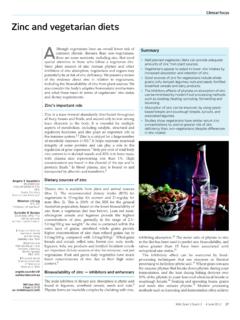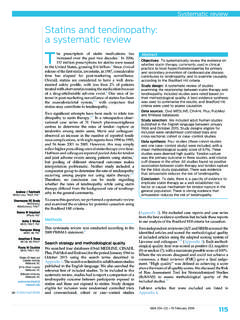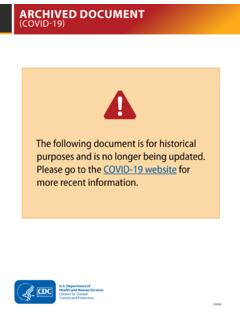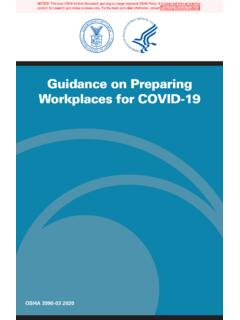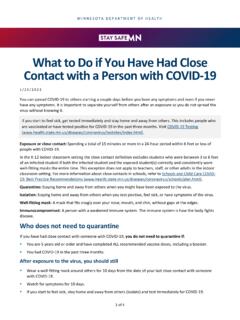Transcription of Updated guidelines for the management of paracetamol ...
1 MJA 212 (4) 2 March 2020175 Guideline summaryUpdated guidelines for the management of paracetamol poisoning in Australia and New ZealandAngela L Chiew1,2, David Reith3, Adam Pomerleau3, Anselm Wong4,5, Katherine Z Isoardi6,7, Jessamine Soderstrom8,9, Nicholas A Buckley2,10 paracetamol poisoning is the commonest cause of severe acute liver injury in Western ,2 It is also the most common reason for calls to Poisons Information Centres in Australia and New Not only is it one of the com-monest medications involved in deliberate self- poisoning, it is also involved in a large proportion of accidental paediatric ex-posures and in overdoses with therapeutic intent when taken for symptoms such as pain or fever (repeated supratherapeutic in-gestions). Since the publication of the previous guidelines in the Medical Journal of Australia in 2015, further research has emerged, particularly regarding acetylcysteine regimens, massive parac-etamol ingestions, and modified release paracetamol ingestion.
2 These have led to a change in management of paracetamol poi-soning, and the 2015 guidelines do not reflect the current prac-tice recommended by clinical toxicologists. The key changes from the previous guidelines are acetylcysteine regimen (two- bag regimen) and dosage, management of patients taking large or massive overdoses, staggered ingestions, modified release paracetamol ingestions and repeated supratherapeutic inges-tion. The full guidelines are available online in the Supporting Treatment of paracetamol Poisoning Writing Group was comprised of clinical toxicologists and pharmacologists from Australia and New Zealand. All members completed a detailed literature review and critically appraised existing evidence, in-cluding reviewing the relevant chapters from the newly Updated Australian Therapeutic guidelines Toxicology and Drafts of evidence- based recommendations, practice points and a background manuscript were developed.
3 We conducted a face- to- face meeting in May 2019 to draft the guideline. Further revisions were made via email and teleconference. The sum-mary recommendations follow the National Health and Medical Research Council levels of evidence (https defau lt/files/ ) and the Grading of Recommendations Assessment, Development and Evaluation (GRADE) system ( worki nggro ) to determine the strength of the deliberate self- poisoning, accidental paediatric exposure and inadvertent repeated supratherapeutic ingestions all require specific approaches to risk assessment and initial approach focuses on risk assessment (Box 1). Key fac-tors to consider for paracetamol poisoning are the formulation and dose ingested, time since ingestion, and serum paracetamol concentration (early), or clinical and laboratory features suggest-ing acute liver injury (late). Serum paracetamol concentration should be used to assess the need for acetylcysteine adminis-tration in all patients presenting with deliberate self- poisoning with paracetamol , regardless of the stated dose.
4 The parac-etamol treatment nomogram (Box 2) can only be used in acute immediate release paracetamol ingestions with a known time of have summarised with flow charts the management of acute immediate release paracetamol ingestion (Box 3), acute modified release paracetamol ingestion (Box 4), repeated supratherapeutic ingestion (Box 5), and a management flow chart for rural and remote centres with limited pathology facilities (Box 6).Acetylcysteine infusionsAcetylcysteine should be administered as a two- bag regimen (Box 7) this has changed from previous guidelines . The standard three- bag intravenous weight- based dosage regimen (150 mg/kg body weight over 15 60 min, then 50 mg/kg over 1 Prince of Wales Hospital and Community Health Services, Sydney, NSW. 2 NSW Poisons Information Centre, Children s Hospital at Westmead, Sydney, NSW. 3 University of Otago, Dunedin, New Zealand. 4 Victorian Poisons Information Centre, Austin Hospital, Melbourne, VIC.)
5 5 Monash Health, Monash University, Melbourne, VIC. 6 Princess Alexandra Hospital, Brisbane, QLD. 7 Queensland Poisons Information Centre, Queensland Children s Hospital, Brisbane, QLD. 8 Royal Perth Hospital, Perth, WA. 9 Western Australia Poisons Information Centre, Sir Charles Gairdner Hospital, Perth, WA. 10 University of Sydney, Sydney, NSW. doi: Podcast with Angela Chiew available at : paracetamol is a common agent taken in deliberate self- poisoning and in accidental overdose in adults and children. paracetamol poisoning is the commonest cause of severe acute liver injury. Since the publication of the previous guidelines in 2015, several studies have changed practice. A working group of experts in the area, with representation from all Poisons Information Centres of Australia and New Zealand, were brought together to produce an Updated evidence- based recommendations (unchanged from previous guidelines ): The optimal management of most patients with paracetamol overdose is usually straightforward.
6 Patients who present early should be given activated charcoal. Patients at risk of hepatotox-icity should receive intravenous acetylcysteine. The paracetamol nomogram is used to assess the need for treat-ment in acute immediate release paracetamol ingestions with a known time of ingestion. Cases that require different management include modified re-lease paracetamol overdoses, large or massive overdoses, acci-dental liquid ingestion in children, and repeated supratherapeutic changes in management in the guidelines : The new guidelines recommend a two-bag acetylcysteine infu-sion regimen (200 mg/kg over 4 h, then 100 mg/kg over 16 h). This has similar efficacy but significantly reduced adverse reactions compared with the previous three-bag regimen. Massive paracetamol overdoses that result in high paracetamol concentrations more than double the nomogram line should be managed with an increased dose of acetylcysteine.
7 All potentially toxic modified release paracetamol ingestions ( 10 g or 200 mg/kg, whichever is less) should receive a full course of acetylcysteine. Patients ingesting 30 g or 500 mg/kg should receive increased doses of summaryMJA 212 (4) 2 March 20201764 h and 100 mg/kg over 16 h; 300 mg/kg total) developed in the 1970s was empirically derived and not subject to dose ranging This regimen has proven to be highly efficacious when compared with no treatment, but it causes frequent adverse re-actions and the dosing regimen is complex and prone to ,7 A two- bag acetylcysteine regimen slows the initial loading dose and simplifies the protocol (ie, 200 mg/kg over 4 h followed by 100 mg/kg over 16 h). This is widely used in toxicology units around Australia and has been shown to significantly reduce the rates of adverse 12 GRADE: Strong; Evidence: release paracetamol ingestionThe management of acute immediate release paracetamol inges-tion defined as any intentional or deliberate self- poisoning is summarised in Box on gastric decontamination have not changed since 2015.
8 Fifty grams of activated charcoal should be administered to a cooperative, awake adult if they present within 2 hours of ingestion of a toxic dose (Box 1) of immedi-ate release paracetamol , or within 4 hours of immediate release paracetamol overdoses greater than 30 15 GRADE: Strong; Evidence: paracetamol treatment nomogram has been validated as an excellent predictor of risk but only for acute ingestions of imme-diate release paracetamol with a known time of ingestion. The current nomogram used in Australia and New Zealand has not changed (Box 3),7 except the units on the left and right axis have now been swapped. It is important to check the units used, with many laboratories recently changing from mol/L (right axis) to mg/L (left axis). GRADE: Strong; Evidence: with a high initial paracetamol concentration (greater than double the nomogram line) are at increased risk of acute liver injury if given standard acetylcysteine ,16,17 Only a small percentage of paracetamol overdoses will have a parac-etamol concentration greater than double the nomogram line and they typically have ingested 30 g or more of paracetamol .
9 Those with an initial paracetamol concentration greater than double the nomogram line may benefit from an increased dose of ,13 The second bag in the two- bag acetylcys-teine regimen should be doubled to 200 mg/kg intravenous acetylcysteine over 16 hours (instead of 100 mg/kg over 16 h). Patients with even higher concentrations (eg, triple the nomo-gram line) may benefit from even higher acetylcysteine ,18 These patients should be discussed with a clinical toxicologist or a Poisons Information Centre. GRADE: Strong; Evidence: the completion of acetylcysteine (ie, 2 h before completion of the infusion), alanine aminotransferase (ALT) should be re-peated in all patients. For patients with an initial paracetamol level greater than double the nomogram line, a paracetamol concentration should also be repeated. Acetylcysteine should be continued if the paracetamol concentration is greater than 10 mg/L (66 mol/L) or ALT is elevated (> 50 U/L) and increas-ing (if baseline ALT > 50 U/L).
10 The normal reference range for ALT varies between pathology laboratories and with patient age; an elevated ALT greater than 50 U/L is considered sig-nificant. Small fluctuations in ALT (eg, 20 U/L or 10%) are common and do not on their own indicate the need for ongoing acetylcysteine. ALT should be repeated in all cases as there is a small (< 1%) risk of developing acute liver injury despite treatment with acetylcysteine within 8 ,17,19,20 GRADE: Strong; Evidence: or staggered immediate release paracetamol ingestionsAny multiple or staggered paracetamol ingestions over more than 2 hours for the purpose of deliberate self- harm are distinct from repeated supratherapeutic ingestions, which are ingestions of excessive paraceta-mol for therapeutic purposes (Box 5). staggered inges-tions should be treated as per acute immediate release paracetamol ingestion (Box 3) using the earliest time of ingestion for the paracetamol nomogram.



